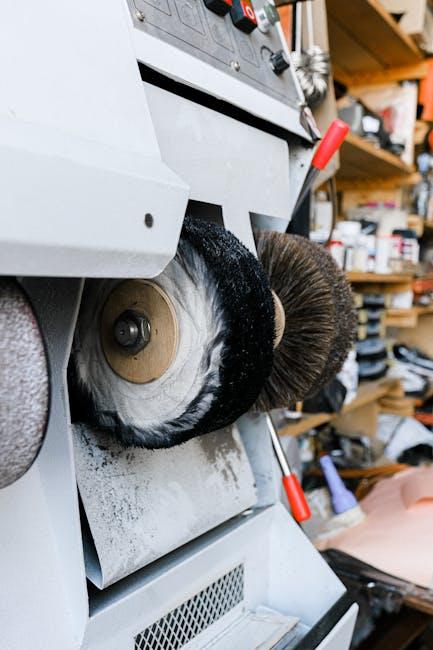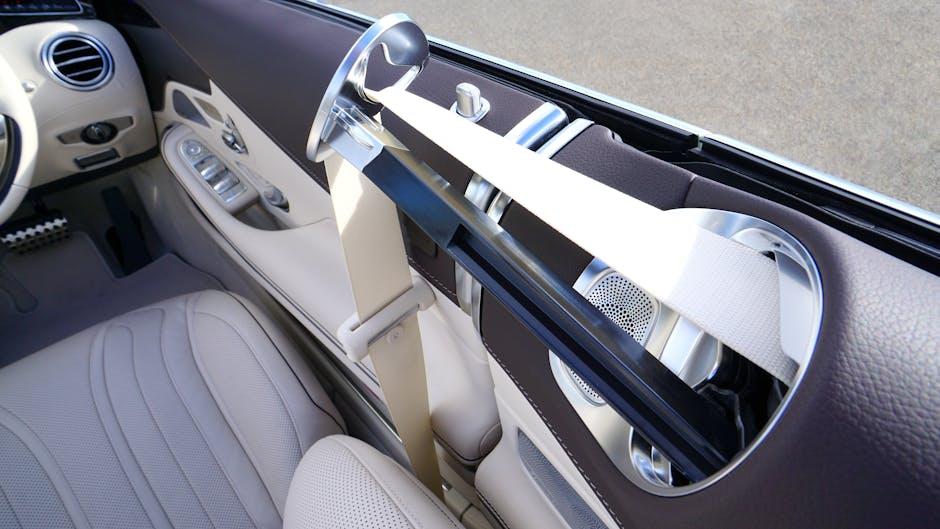Leather seats, with their timeless elegance and luxurious feel, are often the crown jewel of any car’s interior. Yet, their beauty is as delicate as it is durable, requiring thoughtful care to maintain that supple, polished look over time. Whether you’re combating daily dirt, fading from sunlight, or the wear and tear of everyday use, knowing how to properly clean and protect your car’s leather seats is essential. This guide will walk you through practical, effective steps to preserve your leather’s natural charm, ensuring your ride remains both comfortable and stylish for miles to come.
Table of Contents
- Choosing the Right Cleaning Products for Leather Car Seats
- Step-by-Step Guide to Gentle Leather Cleaning Techniques
- Effective Stain Removal Methods for Different Leather Types
- How to Moisturize Leather to Prevent Cracks and Fading
- Protecting Leather Against Sun Damage and Wear
- Routine Maintenance Tips to Extend the Life of Car Leather Seats
- Q&A
- Concluding Remarks

Choosing the Right Cleaning Products for Leather Car Seats
When selecting cleaning supplies for your leather car seats, it’s essential to prioritize products tailored specifically for leather care. Generic household cleaners can strip away natural oils, causing the leather to dry out and crack over time. Look for formulas labeled pH-balanced and non-abrasive to ensure gentle but effective cleaning. Additionally, opt for products free from harsh chemicals like ammonia or bleach, which can discolor or weaken the leather surface.
Consider these factors while choosing the perfect leather cleaner:
- Moisturizing Ingredients: Ingredients like lanolin or natural oils help maintain flexibility.
- Residue-Free: Prevent buildup that attracts dirt and grime.
- Easy Application: Spray or foam formulas can reduce over-saturation risks.
| Product Type | Best For | Key Benefit |
|---|---|---|
| Leather Cleaner Spray | Quick maintenance | Fast application, light cleaning |
| Conditioning Cream | Deep nourishment | Restores moisture and suppleness |
| Foam Cleaner | Delicate surfaces | Gentle, residue-free cleansing |

Step-by-Step Guide to Gentle Leather Cleaning Techniques
To preserve the natural beauty of your car’s leather seats, start by vacuuming gently to remove dirt and debris nestled in the seams. Use a soft brush attachment to avoid scratching the leather surface. Next, prepare a mild cleaning solution by mixing distilled water with a few drops of a gentle, pH-balanced leather cleaner or unscented castile soap. Lightly dampen a microfiber cloth with this solution, ensuring it’s not soaked, and softly wipe the leather in circular motions. This technique helps lift grime without oversaturating the material, which could cause damage over time.
After cleaning, it’s crucial to condition the leather to maintain its suppleness and prevent cracking. Apply a small amount of a high-quality leather conditioner onto a fresh microfiber cloth and rub it evenly into the seat’s surface. Let it absorb for about 15 minutes, then buff away any excess with a dry cloth for a smooth, polished finish. Remember these key points:
- Do not use harsh chemicals or household cleaners.
- Avoid excess water, which can stain or weaken leather fibers.
- Perform a spot test on hidden areas before full application.
- Keep your car ventilated to help leather breathe and remain fresh.

Effective Stain Removal Methods for Different Leather Types
Leather car seats come in various types, each demanding specific care to remove stains without damage. For aniline leather, which is soft and porous, use a minimal amount of mild soap diluted in water. Gently blot the stain with a microfiber cloth, avoiding vigorous rubbing that can spread the discoloration. Meanwhile, semi-aniline leather allows for a slightly stronger cleaning solution but always test a small hidden area first. For tougher spills, a commercial leather cleaner formulated for semi-aniline varieties can effectively lift dirt without stripping the natural oils.
For protected or coated leather, stain removal is more forgiving due to the surface sealant. Begin with a dry cloth to absorb excess liquid, then clean with a damp cloth using either a pH-balanced leather cleaner or a mix of water and vinegar. Avoid harsh chemicals or abrasive tools across all leather types to maintain their aesthetic and durability. The table below summarizes practical stain removal tips per leather type:
| Leather Type | Cleaning Agent | Technique | Precautions |
|---|---|---|---|
| Aniline | Mild soap, water | Blot gently, avoid rubbing | Test on hidden spot first |
| Semi-Aniline | Leather cleaner, mild soap | Use soft cloth, moderate pressure | Do not saturate leather |
| Protected/Coated | Water-vinegar mix, leather cleaner | Wipe gently, absorb liquids quickly | Avoid harsh chemicals |

How to Moisturize Leather to Prevent Cracks and Fading
To maintain the supple texture and rich color of your car’s leather seats, regular moisturizing is essential. Start by selecting a high-quality leather conditioner tailored specifically for automotive interiors. These products penetrate deeply into the leather fibers, replenishing natural oils that evaporate over time due to exposure to sunlight and frequent use. Before applying, gently clean the seats with a damp microfiber cloth to remove surface dust and dirt, ensuring better absorption of the conditioner.
When moisturizing, use a soft, lint-free applicator or a microfiber cloth to evenly spread a thin layer of conditioner. Avoid over-saturating the leather, as excessive product can clog pores and cause discoloration. For best results, focus especially on areas that endure constant friction or where cracking has begun. Repeat this process every 3-4 months, or more frequently in harsh climates to preserve the leather’s durability and vibrancy.
- Test conditioner on a hidden seam before full application
- Apply in circular motions for uniform coverage
- Allow time for absorption before wiping off excess
- Keep seats out of direct sunlight after treatment

Protecting Leather Against Sun Damage and Wear
Prolonging the life of your car’s leather seats means taking active steps against the relentless effects of sunlight and everyday wear. UV rays can cause leather to dry out, crack, and fade, so it’s essential to intervene before the damage becomes visible. Start by regularly applying a high-quality leather conditioner with UV protection. This creates a protective barrier that keeps moisture locked in and prevents harmful rays from breaking down the fibers. Pair this with window tints or sunshades to reduce direct exposure, especially during long parking sessions under the sun.
Daily wear and friction can dull the leather’s finish and create weak spots over time. To combat this, maintain a routine that includes gentle cleaning with pH-balanced leather cleaners, followed by conditioning to restore suppleness. Avoid harsh chemicals or abrasive tools that can strip away natural oils. Below is a quick care guide you can follow:
| Care Step | Frequency | Recommended Product Type |
|---|---|---|
| Dust and Clean | Weekly | pH-balanced Leather Cleaner |
| Condition & Protect | Monthly | UV-protected Leather Conditioner |
| Use Sunshades | Every time park in sun | Reflective Car Shades |

Routine Maintenance Tips to Extend the Life of Car Leather Seats
Keeping your car leather seats in pristine condition requires consistent care, but it doesn’t have to be complicated. Start by regularly dusting and vacuuming the seats to remove dirt particles that can cause abrasion and wear over time. Use a soft brush attachment on your vacuum to avoid scratching the leather surface. Incorporate a gentle wipe-down with a damp microfiber cloth weekly to maintain the seats’ natural sheen and prevent buildup of grime. Another crucial step is to keep your vehicle’s interior climate-controlled, as excessive heat and sunlight can dry out leather, leading to cracks and fading.
To further nurture your leather seats, follow a simple routine every few months that includes conditioning and protecting. Use a high-quality leather conditioner to replenish the natural oils and keep the material supple; apply it evenly with a clean cloth and let it absorb fully before buffing away any excess. To shield your investment against stains and spills, apply a leather protectant that forms a barrier without compromising breathability. Here’s a quick reference table to guide your maintenance intervals:
| Task | Frequency | Tip |
|---|---|---|
| Vacuum & Dust | Weekly | Use soft brush attachment |
| Damp Wipe | Weekly | Microfiber cloth only |
| Leather Conditioning | 3-4 months | Avoid oil-based products |
| Leather Protection | 3-4 months | Apply on clean, dry surface |
Q&A
Q&A: How to Clean and Protect Car Leather Seats
Q1: Why is it important to clean and protect car leather seats?
A1: Leather seats add a touch of luxury and comfort to your car, but they are also prone to wear and tear. Cleaning and protecting them regularly helps maintain their appearance, prevents cracking and fading, and extends their lifespan.
Q2: What materials and products do I need for cleaning leather car seats?
A2: To properly clean leather seats, you’ll need a soft microfiber cloth, a gentle leather cleaner (preferably pH-balanced), a soft brush for stubborn dirt, and a leather conditioner to seal in moisture and protect the surface.
Q3: Can I use household cleaners on car leather?
A3: It’s best to avoid household cleaners like bleach, ammonia, or harsh detergents, which can strip natural oils and damage the leather. Instead, stick to products designed specifically for automotive leather.
Q4: What is the step-by-step process for cleaning leather seats?
A4: Start by vacuuming the seats to remove loose dirt and debris. Apply the leather cleaner gently with a microfiber cloth or soft brush, working in small sections. Wipe away the cleaner with a clean damp cloth and let the seats dry naturally before applying leather conditioner.
Q5: How often should I clean and condition my leather seats?
A5: For best results, clean your leather seats every 3 months and condition them every 4 to 6 months. In hot or dry climates, you might want to condition more frequently to prevent dryness and cracking.
Q6: Are there any DIY remedies for leather cleaning?
A6: While some people suggest using diluted vinegar or olive oil, these remedies can sometimes harm the leather or leave residues. It’s safer to rely on products made for leather care to avoid unintended damage.
Q7: How can I protect leather seats from future damage?
A7: Alongside conditioning, consider using seat covers if exposing your car to harsh sunlight or heavy use. Parking in shaded areas or using sunshades reduces UV damage. Promptly clean spills to avoid stains setting into the leather.
Q8: What signs indicate my leather seats need professional care?
A8: If your leather shows extensive cracking, deep stains, or persistent odors despite regular cleaning, it might be time to consult a professional detailer who can provide specialized treatments to restore your seats.
Q9: Can all leather types in cars be cleaned the same way?
A9: Different leather finishes—aniline, semi-aniline, pigmented—respond differently to cleaning. Pigmented leather (common in cars) is more durable and easier to clean, while aniline leather is more delicate. Always check your manufacturer’s recommendations.
Q10: Does protecting leather seats improve resale value?
A10: Absolutely. Well-maintained leather seats suggest overall care of the vehicle, making your car more attractive to buyers and potentially increasing its resale value. Clean, supple seats reflect pride in ownership and attention to detail.
Concluding Remarks
Caring for your car’s leather seats is more than just a routine chore—it’s a way to preserve the elegance and comfort that make every drive a pleasure. By following simple cleaning and protection steps, you not only extend the life of your seats but also keep your vehicle’s interior looking fresh and inviting. Remember, a little attention today can save you from costly repairs tomorrow, ensuring that every journey is enjoyed in style and comfort. So, treat your leather seats with the care they deserve, and watch your car’s interior age gracefully alongside you.


5 Comments
040ln7
040ln7
2mfcpg
c7maai
q62ekp